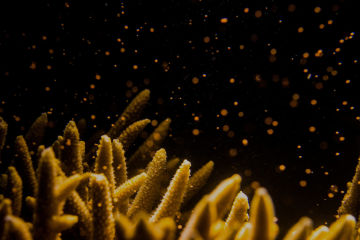Explainers ·
What is rubble stabilisation?
What it is, why it’s needed and how it’s helping new coral reefs form.
Coral reefs can be degraded and damaged by acute events that kill corals, like severe coral bleaching, cyclones and ship strikes.
These disturbances can break large areas of coral down into rubble beds, which are made up of pieces of dead coral skeletons and rock fragments that can constantly move with the tides and waves.
Rubble stabilisation refers to innovative techniques that help secure this loose rubble to allow young corals to survive and grow in the rubble beds, to form stable new reefs.

A coral rubble field. Credit: Peter Mumby
#How does coral rubble impact reef recovery?
We know it’s often much harder for baby corals to settle and grow on unstable and moving surfaces. Corals that manage to settle on loose rubble pieces can get killed as they tumble around with the waves and the currents. Where rubble forms, the ability of our Reef to naturally recover with each new generation is limited.
Rubble formation is a natural process that plays an important ecological role on our reefs. In a natural system and over time, rubble beds will eventually stabilise again with the help of natural binders like encrusting algae and sponges, to form a stable platform for new corals.
With increased bleaching events, storms and cyclones being caused by climate change however, the amount of rubble created on the Reef is rising. Where increased unstable rubble restricts new coral growth, we may need to intervene to artificially stabilise these areas.
#How does rubble stabilisation work?
Researchers currently help reefs recover from increased rubble using two main approaches:
1. Stabilising rubble areas using artificial means, eg. mesh netting or carbonate rocks
2. Replacing damaged or lost reef with new structures, like specially-designed 3D shapes or even net bags filled with rocks.
These efforts are labour-intensive and only happen at small scales on individual sections of a reef, so identifying where and when an area is vulnerable to rubble, and whether restoration efforts will persist despite waves and tides, is critical.

Rubble researchers at the University of Queensland’s School of Civil Engineering use specially-designed tanks to measure the impact of waves of different types of reef rubble. Credit: University of Queensland
#Why is researching rubble stabilisation important?
Currently, relatively little is known about rubble formation on the Great Barrier Reef, or whether restoration efforts will be effective over the long-term at helping natural reef recovery.
As part of the Reef Restoration and Adaptation Program (RRAP), researchers from the University of Queensland and QUT are addressing these knowledge gaps. They're estimating where and to what extent rubble will form, which areas might recover quickly via natural binders, which areas might need artificial stabilisation, and which stabilisation methods will work best.
The aim is to build a Reef-wide rubble risk map, as well as guidance tools that can help Reef managers determine where and when they should stabilise.
Watch RRAP researchers in action in this video produced for the University of Queensland, by BBC StoryWorks Commercial Productions.
The Reef Restoration and Adaptation Program is the world’s largest effort to help a significant ecosystem survive climate change. Our partners include the Australian Institute of Marine Science, CSIRO, Southern Cross University, James Cook University, QUT and the University of Queensland.
#Related

Explainers ·
What is coral spawning?

Explainers ·
Uncovering hidden species with eDNA

Explainers ·
What is biodiversity and why is it so important?

Explainers ·
